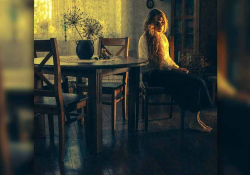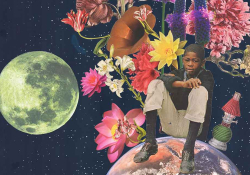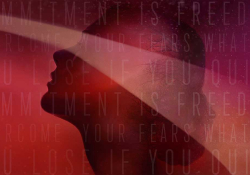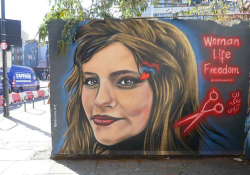Maggie Gyllenhaal’s Lost Daughter: A Marvelous Betrayal

An Italian film scholar reviews Maggie Gyllenhaal’s film adaptation of Elena Ferrante’s novel The Lost Daughter and finds a powerful interpretation that, although it sometimes strays from the original, deserves praise on its own merit.
The glorious city of Naples is absent in The Lost Daughter, directed by Maggie Gyllenhaal, a sophisticated, moody, gripping directorial debut that is also the adaptation of Elena Ferrante’s slim novel, first published in Italian as La figlia oscura in 2006 and finely translated into English by Ann Goldstein for Europa Editions in 2008.
This absence is disappointing for an audience that can’t help but associate the film with the author of the Neapolitan quartet—and simultaneously confronted with the dazzling city in another film that also premiered at the 78th Venice International Film Festival in 2021, The Hand of God, by Paolo Sorrentino. While the latter was awarded the Grand Jury Prize, The Lost Daughter received a thoroughly deserved prize for the best screenplay. However, it could have certainly aspired to other coveted Venetian trophies given the stellar performance of lead actresses Olivia Colman and Jessie Buckley; the stunning photography, in which the warm sfumato light of happy flashbacks alternates with the creepy chiaroscuro of past and present dark spots in the protagonist’s psyche; not to mention the achingly beautiful score sounding “like a vintage vinyl record from the ’50s or ’60s”; or the outstanding performances of actors in supporting roles, including Dakota Johnson, among others.
True, The Lost Daughter has moved on to seduce other juries and other audiences after Venice. At the Gotham Awards, it won best feature, breakthrough director, outstanding lead performance, and best screenplay. It was also awarded the New York Film Critics Circle Award for Best First Film 2021, while Olivia Colman won best actress at the SFBAFCC.
But the absence of Naples, where the protagonist of Ferrante’s book hails from and by which her internal landscape is permeated, is perhaps one of the reasons why, despite the well-deserved critical appraisal attributed to the film, part of the audience, including readers of Ferrante’s work, might have some reservations about it.
Initially, switching one seaside destination for another might not seem like a big deal. The unnamed village of southern Italy that welcomes the protagonist, Leda (Olivia Colman), in the book is replaced in the adapted story by another enchanting location, the fictional island of Kyopeli in Greece. With the glistening surface of the Mediterranean Sea ideally joining the two places, one could even argue for Gyllenhaal’s choice to be a tribute to the “global” dimension of Ferrante’s novels, encapsulated in the microdimension of the local village or neighborhood and a big element behind Ferrante’s success, as argued by Italian critic Tiziana de Rogatis.
Other than this, the storyline follows the book very closely, or so it seems. Leda, a middle-aged academic, travels southbound with suitcases full of books, looking forward to a working vacation during which she will engage in some deep thinking and meaningful reading while fully immersed in nature (as academics do!). As she settles in her new, idyllic place—the flat to which she is welcomed by expat caretaker Lyle (Ed Harris) and the lido overseen by Irish student and lifeguard Will (Paul Mescal)—Leda starts obsessing on the beach with a mother-daughter couple, Nina (Dakota Johnson) and Elena (Athena Martin), who are part of a noisy, uncouth group of American holiday-goers resident in Queens but of Greek descent. Viewers initially understand Leda’s interest as a nostalgic throwback to her own past, as images of a much younger Leda (Jessie Buckley) and her two daughters, Bianca (Robyn Elwell) and Martha (Ellie Blake), appear on the screen. But soon it becomes clear that motherhood is a problematic bone of contention, its joys and horrors, its “crushing responsibilities” and asphyxiating interdependence. This is where things get complicated. And this is also where the absence of Naples is a betrayal difficult to overcome.
In the book version, the rowdy gang, labeled by Leda as “the Neapolitans,” is immediately recognized by the readers as potentially dangerous, possibly linked to the mafia underworld. The stereotypical culture and class divide that used to split Italy along clear geographical lines separating North and South is an easy stratagem adopted by Ferrante to suggest why the hypereducated Leda is bothered by her neighbors. The use of Neapolitan dialect as the language spoken by Nina’s family, as opposed to the standard Italian of the polished, educated, upper classes, is a clear expression of that difference.
As an academic, Leda is repelled by a reality from which she feels miles removed. However, at the same time, she is attracted to it, giving that—as readers quickly discover—she is also of Neapolitan descent, thus coming from a similar background to that of Nina’s family.
In Gyllenhaal’s film, all this subtext is transported to an anglophone dimension but is lost in translation. Leda lives in Cambridge, near Boston, so she is probably a professor at Harvard but comes from Shipley, near Leeds, in the industrial North of England. In a quick but intense exchange between Nina’s sister-in-law Callie (Dagmara Domińczyk) and Leda, the former asks where Leda’s “people” are from, then remarks that despite her British accent, Leda has an air of familiarity, as if she were from Queens. This is a hint to the viewers that there is something dark and different lurking underneath Leda’s past, which will be revealed much later in the film, when Shipley is vehemently defined as a “dark shithole” and Leda’s mother as someone without education. However, at this stage, the conversation between Callie and Leda is a distant memory. The beautiful linguistic subtext through which language, place, and class intersect one another—creating subterranean links between Leda and the gang from Queens—is lost; and so is what Katrin Wehling-Giorgi refers to as “the significance of Leda’s emancipation from a complex, and often oppressive condition of women in the Mediterranean South.”
What is also gone, with the Neapolitan dialect missing, is a stronger feeling of in-betweenness.
What is also gone, with the Neapolitan dialect missing, is a stronger feeling of in-betweenness, of being on the edge and on the margins, torn between nature—the DNA of her own “people” speaking the language of the uneducated working class—and culture—the life of poetry, literary criticism, and “fancy” accents that Leda has embraced.
In Ferrante’s book this sense of liminality is reinforced continuously, in several ways. When the protagonist arrives at her new home at nighttime, “everything is undefined, every object is easily exaggerated” and she feels that she has “no contours.” The lido itself is a borderland, the space in which nature and culture, past and present, meet. It is a “natureculture,” a place where nature, particularly the sea, could be at its wildest (captured in some gorgeous stormy scenes in the film) but also at its most regimented, as industrious humans tame the wilderness into manicured landscapes punctuated by orderly rows of sunshades and lounge chairs.
It could be argued that, when Olivia Colman lands in Kyopeli, Gyllenhaal also conveys such in-betweenness via the contrast between an out-of-focus background scenery and a crystal-clear foreground. When Leda steps out of the car to gaze at the lido, and only at that point, the blurry landscape comes into focus. This could signal to the audience that everything is seen from Leda’s point of view, but, then again, inside the apartment lines and “contours” of objects meld with the dark environment except for one item that is given special resonance: a bowl of polished, luminous fruit on the table. The clever use of light and the skilled camerawork certainly suggests a fuzziness of the mind and a sense of unease, echoing the feelings of the opening scenes in which we have seen close-ups of Leda walking unsteadily toward the sea at nighttime and then collapsing, a puppetlike dead body. Generally speaking, throughout the film, Gyllenhaal’s style of extreme close-up shots combined at times with a shaky handheld camera succeeds in evoking a sense of claustrophobic proximity that hints, in fact, to a trespassing of bodily and mental boundaries.
However, the multiple ways in which the margins of reality are dissolving in Leda’s mind and in her surroundings, as described in the book, with the neat separation between nature and culture being questioned by Ferrante, are not entirely captured in the film. Some key aspects that are toned down or divested of their profound meaning in the adaptation are linked to the centrality Ferrante gives to everything that is “nonhuman,” such as plants, animals, and inanimate objects that become characters in their own right.
A case in point is a detail that may seem quite insignificant in the film—except as an omen or a marginal element of the plot—namely, the pinecone that hits Leda as she makes her way back from the beach after challenging the gang from Queens. Leda, whose mood has been soured by the arrogance of Callie’s family when she refused to move to a different sunshade, climbs up through the wood and is violently hit on the back by a pinecone, flung horizontally at her from behind. As the character stares upward toward the branches, a hint is given to the audience that the pinecone could not just have fallen off the tree. If so, the blow would have been a lot weaker. Could anyone have thrown it intentionally? Nobody is in sight, but the audience cannot help but presume a retaliation from the offended Americans.
This is also one of the hypotheses considered in the book but immediately discarded: the place is so quiet that Leda would have heard the steps of the perpetrator as he ran away. So, what then? The answer, again, is in Leda’s relationship with her own Neapolitan family, which the film doesn’t show. In Ferrante’s book, the first time Leda walks through the pine wood to reach the lido, she is overwhelmed by a scent of resin that reminds her of her mother crushing pinecones and dishing out the fruits to all her daughters except Leda, “waiting in silent expectation.” There will be no fruits for Leda because she is too shy and her mother wants to teach her a lesson: “none for you, you’re worse than a green pinecone.”
So when the adult Leda is struck by a pinecone, which causes her a great deal of pain and a terrible bruise, it is nearly as if she had been hit by her mother or by her own self, the shy creature from her past, silent and separate from her mother and siblings and yet, reluctantly, part of them. That creature has been evoked and unleashed by the unwanted proximity with the “Neapolitans,” whom she is attracted to and rejects at the same time.
All this subtext is not in the film. A pinecone is a pinecone.
All this subtext is not in the film. A pinecone is a pinecone. It is not alive. It is not a nonhuman object encapsulating Leda’s human identity. But this is a core issue. Adopting a nonanthropocentric stance, allowing pinecones to intentionally hit people (as well as pots to explode and paintings to self-destroy as happens in My Brilliant Friend) corresponds to Ferrante’s own belief that we have “the responsibility of writing . . . about beings human and non-human, rocks, plants . . . crossing borders, disintegrating, integrating, inventing.” If we really want to modify our knowledge of the world—implies Ferrante—we need to disassemble its fixed image and believe in a world with porous boundaries in which everything has equivalent agency. If we keep believing that a pinecone is just a pinecone, or a doll just a doll, we will remain attached to an obsolete idea of the world in which there is space only for a reality and its opposite, such as “good” or “bad” mothers, and nothing in between.
This leads me to the eerie doll belonging to little Elena and taken by Leda on the beach. The protagonist does not know why she has stolen it. In the book, readers are warned from the very beginning that the whole story emerges from “a gesture of mine that made no sense.” In the film, such a warning is not there, and viewers are left wondering whether, in fact, Leda is an unhinged, psychotic woman who stole Elena’s doll to hurt the child or to atone for the pain she caused her own children when she was young. Indeed, after taking the doll and “playing” with it back in the apartment, Leda starts having terrible flashbacks of her younger self treating her children in a cruel way.
But if one follows Ferrante’s nonanthropocentric logic, Nani the doll is not just a puppet made of plastic, nylon, and fabric. Like the pinecone, it is an object interconnected with two human beings, Elena and Nina, who are bound to it and instill their life in it through their voices. Taking the doll means undoing the bond between mother and daughter, which Leda finds attractive and repugnant at the same time. In stealing the doll, the protagonist of the book is subconsciously trying to appropriate that relationship, unpack it, and compare it to her own “bad” motherhood. Overcoming the disgust that she feels for the viscous fluids leaking out of the doll—like the rotten fruit and the squashed cicada earlier on in the film—is an integral part of Leda’s journey of discovery, as brilliantly illustrated by Stiliana Milkova.
At stake is, again, the fine line between nature and culture. Ferrante seems to wonder, Is there such a thing as a good (natural) and bad (unnatural) mother, or is it not the case of motherhood being a cultural construct? Are women asked to renounce their careers and their ambitions in the name of an idealized model of motherhood and otherwise be labeled as bad mothers? Are we, both mothers and daughters, like those dolls—objectifiable, silenced, manipulated?
If the questioning of motherhood is pursued and achieved in the film, mainly thanks to Colman’s and Buckley’s superb acting, what is lost is that sense of “undoing” the relationship between Elena and Nina, which should have been portrayed as more idyllic at the beginning, and the lifelike quality of the doll, Nani. We could say that Nani is like a child keeping together a couple and has the same agency as a child.
What Gyllenhaal has depicted in a superb way, in my opinion, is the world of conferences and dinner parties, dominated by a minor stardom of sleazy male academics who are nonetheless charming and powerful within the confines of the intellectual realm, especially to the eye of young female scholars like Leda, starved for attention and consumed by literary passions. The affair between Professor Hardy (Peter Sarsgaard) and young Leda is certainly one of the high points of this film, and so are all the flashbacks in which Jessie Buckley delivers a groundbreaking performance as a “mean” mother and promising academic whose ambitions are suffocated by her family obligations. Olivia Colman as the more mature Leda is also very convincing as a smug academic unable, at times, to connect with real people, as can be seen in the exhilarating dinner scene with young, drunk, and slightly bored Will, who goes all glassy-eyed when Leda starts reminiscing about the emotional anguish experienced by her daughters growing up.
Like all great translations, it could not but stray from the original.
Overall, as Ferrante states in a recent interview, Gyllenhaal’s “film seems scrupulously close to the book precisely because it has the faithfulness of betrayal.” Like all great translations, it could not but stray from the original. True, it might have wandered off too far at times, such as when attempting to translate Ferrante’s poetics of frantumaglia—a feeling of disintegration of mental and bodily boundaries caused by the crushing trauma of patriarchal oppression—through Leda’s repeated dizzy spells. In exchange, however, she gave us the gift of a powerful interpretation that deserves praise on its own merit and hopefully will pave the way to further thought-provoking work by this exciting new director.
Trinity College, Dublin
















